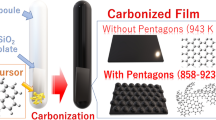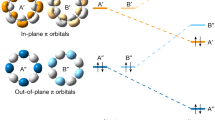Abstract
Do the chemical properties of the surface of a carbon sheet depend on its shape? This question addresses a criterion for chemical behaviour that has hardly been investigated previously. The current neglect of this question may be due to the fact that suitable model systems with easily distinguishable graphitic surfaces were essentially unknown until the discovery [1] and synthesis [2,3,4] of fullerenes, nanotubes and other related forms of carbon. In this study, we present the first systematic comparison of the chemical behaviour of the convex outer and the concave inner surfaces of C60 by analysing the results of semiempirical and DFT calculations on exohedral and endohedral complexes with H- and F-atoms as well as with the methyl radical. We show that such extremely reactive species are trapped by the extraordinary inert inner surface of C60 and do not undergo chemical reactions.
Similar content being viewed by others
Author information
Authors and Affiliations
Electronic Supplementary Material
Rights and permissions
About this article
Cite this article
Mauser, H., Hirsch, A., Hommes, N. et al. Chemistry of Convex versus Concave Carbon: The Reactive Exterior and the Inert Interior of C60 . J Mol Model 3, 415–422 (1997). https://doi.org/10.1007/s008940050059
Received:
Accepted:
Published:
Issue Date:
DOI: https://doi.org/10.1007/s008940050059




